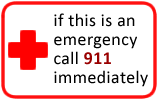Tear Duct - Blocked
Tear Duct - Blocked
Does this describe your child's symptoms? |
Definition
Symptoms
Cause
|
When to Call Your Doctor |
Call Your Doctor Now (night or day) If |
|
|
|
Call Your Doctor Within 24 Hours (between 9 am and 4 pm) If |
|
|
|
Call Your Doctor During Weekday Office Hours If |
|
|
|
Parent Care at Home If |
|
|
HOME CARE ADVICE FOR BLOCKED TEAR DUCT |
Reassurance:
A blocked tear duct is a common condition that affects 10% of newborns.
Both sides are blocked 30% of the time.
A blocked tear duct requires no treatment unless it becomes infected.
Pus in the Eye:
Lots of pus in the eye or eyelids stuck together (EXCEPTION: only in corner of the eye) means a secondary infection has occurred.
This is common with blocked tear ducts and should clear up in a few days with prescription antibiotic eyedrops or ointment.
Call or see your child's doctor for a prescription. In the meantime, do the following:
Remove Pus: Remove the dried and liquid pus from the eyelids with warm water and wet cotton balls several times per day. Once you have antibiotic eyedrops, they will not work unless the pus is removed each time before they are put in.
Massage:
Some physicians recommend routine massage of the lacrimal sac (where tears collect) twice a day, others do not. Massage is not required. The tear duct will open without any massage. If massage is recommended, do the following:
The lacrimal sac is in the inner lower corner of the eye. This sac can be massaged to empty it of old fluids and to check for early infection.
A cotton swab works much better than a finger.
Start at the inner corner of the eye and press upward. Be very gentle.
Clear fluid should come out of the corner of the eye.
Expected Course: Over 90% of tear ducts open up spontaneously by the time the child is 12 months of age.
Call Your Doctor If:
Eye becomes infected
Eyelid becomes red or swollen
Your child becomes worse
And remember, contact your doctor if your child develops any of the "Call Your Doctor" symptoms.
Updated:
March 22, 2017



